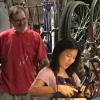Winter Is Coming
Greensplainer

Winter is coming, and the sound of whirring heat pumps fills the Athens nights. In my June 10 column, I explained how air conditioning works, and while a heat pump is basically a reverse air conditioner—or more precisely, an air conditioner that can move heat in either direction—energy-saving advice for heat pumps is not as simple as that for cooling.
A residential heat pump system really has two heating subsystems: the primary reversible heat pump that does most of the work, and the auxiliary heater in the fan unit that kicks in when the primary doesn’t have enough oomph to heat the house. In most cases, the auxiliary is an electric resistance heater (think electric stove burner), which, if you recall from my Sept. 16 column, has low overall efficiency between the coal mine or gas well and your house. Bottom line: When the “aux” heat runs, it gets expensive.
A heat pump, like an air conditioner, is just a big refrigerator, but in this case the outside world is where the food would be, and your house is where the “waste” heat goes. So, the coil in the outdoor unit is colder than the ambient air and wants to pick up heat from it, while the coil in the fan unit gets hot, and the fan blows the heat around the house.
In moderate conditions, heat pumps are more efficient than straight-up electric resistance heat by about three-to-one. Problems arise when the outside temperature approaches freezing and there is less of a difference in temperature between the outside air and the cold coil trying to pull heat from it. In short, as the outside temperature drops, so does the efficiency (electricity in versus heat output) of the heat pump. In fact, it approaches the efficiency of a resistance heater, so the system just switches on the auxiliary to help out, at which point you’ve got regular electric heat like people from the ‘70s gripe about.
Another problem with heat pumps is they're kinda wimpy compared to gas furnaces, so if you turn the thermostat down when you leave the house, it takes a long time to get back up to temperature later—unless the auxiliary heat kicks in. Most heat-pump thermostats are set at the factory to activate the auxiliary heat if there is more than a three-degree gap between the room temperature and the desired setpoint, because usually people don't want to wait. This is the crux of the common but somewhat misguided advice to leave the heat-pump thermostat at one temperature all winter, around the clock: If you set the temperature back 10 degrees, when you turn it back up, the auxiliary heat will work for at least seven degrees of recovery. This is especially expensive if you have switched to a rate with a demand charge (see my Aug. 19 column), and even worse for commercial customers on a Power and Light rate.
Heat is always trying to pass through your building envelope in the winter, and just like in summer, it moves faster when the temperature difference is higher between inside and outside. So, keeping your heat at a constant temperature does waste energy when you’re not home, and in many cases it can cost more to keep it at one temperature than it costs to run the auxiliary heat to get back up to temperature from a lower one when you get home every day.
Luckily, thermostats are getting smarter. The Nest has a special heat pump function that optimizes the balance between the auxiliary and main systems, with an option to maximize comfort or minimize cost. (Sorry, can’t have both at once.) Newer run-of-the-mill heat-pump thermostats have similar options. Even some older thermostats can be tweaked by a service tech to increase the temperature gap that activates the auxiliary heat. In any case, a setback of five to six degrees Fahrenheit is a good rule of thumb to start with, both overnight and when you’re away. Remember, when it’s really cold, there is little to no difference in efficiency between the two modes.
More by Jason Perry
-

-

BikeAthens Expands Bike Recycling Program in New Space
Greensplainer
-

A Glaring Problem With Athens' New Streetlights
Greensplainer









comments